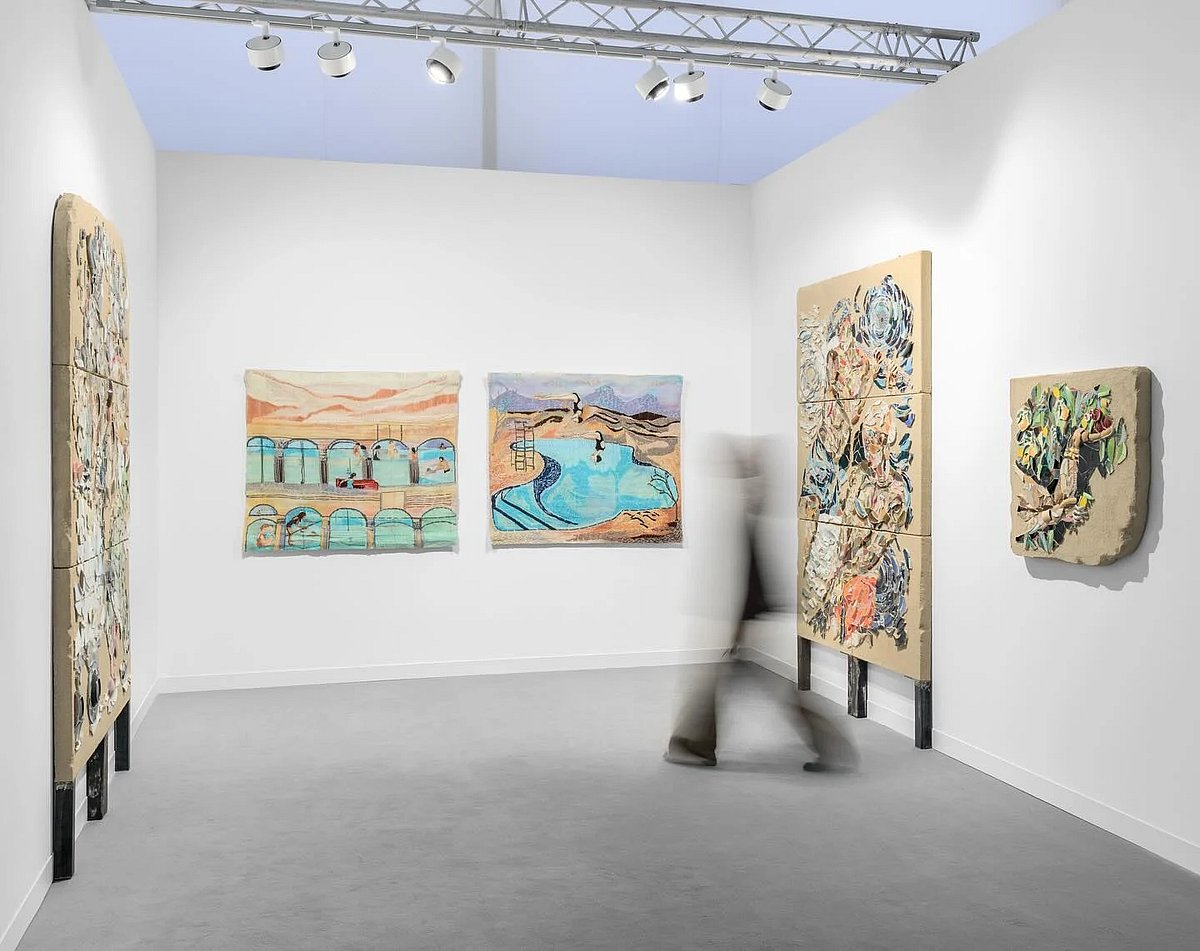A day at Frieze London with The Kurator
Our highlights from this year’s edition of the renowned art fair

There’s no way London may f-r-e-e-z-e during Frieze. The city pulses with energy as art enthusiasts, some having flown in from the farthest corners of the world, gather to take part in one of the most prestigious art events globally. Simply attending Frieze in the British capital is an experience in itself, and The Kurator embarked on a one-day journey into the fair, wrapped in luxury and told with excitement.
On a crisp autumn morning, while sipping an exceptionally delicious café latte and gazing out at the towering trees of Cadogan Gardens from the elegant window of the Jumeirah Carlton Tower, we booked our premium ride to Frieze through the Wheely app. Gliding through the city streets, we arrived at Frieze London, greeted by a large sign at the entrance of Regent’s Park welcoming us to the fair’s 23rd edition.
We made our way through the Grand Entrance into the main fair, which showcased contemporary art across a diverse range of mediums. Frieze London is a true reflection of the city’s character, shaped by global perspectives, with ambitious solo and duo presentations, artist-to-artist selections, and curated sections that offer fresh viewpoints and capture the breadth and urgency of contemporary art today.
We began a mesmerising journey through an astonishing array of artworks presented by 160 galleries from 43 countries - and there was so much to see. Somewhere in Zone D, a tower of aluminium and enamel dishes caught the eye at Selma Feriani Gallery. It was one of Maha Malluh’s new works created for the fair, titled Food for Thought (Shinana) and Food for Thought (Mathloutha). The Saudi artist’s practice reflects the rapid social and cultural transformations of Saudi Arabia. By repurposing everyday objects into assemblages and photograms, she constructs a material archive that both mourns and celebrates a shifting cultural identity — as the gallery’s description puts it.
In a different zone, Almine Rech gallery presented a striking figure by Lebanese-born contemporary artist Ali Cherri, a work made of clay, sand, and pigments, wearing a Munuye mask. Rising from the earth like ruins reborn, with a tongue of fire, the sculpture evokes what we bury and what refuses to disappear. Clay remembers the heat of its making; its silence is not emptiness, but endurance. Cherri’s practice delves into archaeology, heritage, and the intersections of nature, economy, and culture.
A few meters further down, the Focus section held its place at the heart of the fair following the successful redesign of Frieze London 2024. Dedicated to emerging galleries up to 12 years old, it offered a more intimate pace for discovery.
There, Cairo’s Gypsum Gallery stood out as a quiet retreat. The booth presented a thoughtful two-person show by Egyptian female artists.
Yasmine El Meleegy’s delicate wall sculptures—crafted from ceramic fragments of porcelain dinnerware—reflect on Alexandria’s industrial heritage and the shifting boundaries between labour and leisure in the port city.
In contrast, Marianne Fahmy’s hand-stitched tapestries and mixed-media works gently unravel environmental and socio-political narratives surrounding Alexandria’s uncertain future, touching on themes of land subsidence and rising sea levels.
Next, a must-stop was Vadehra Art Gallery, based in New Delhi—a leading South Asian gallery representing multiple generations of artists from the Indian Subcontinent. This year, the gallery presented a booth titled “Sometimes, Ceaselessly, You Run Towards,” spotlighting female voices from South Asia through works in painting, watercolor, sculpture, ceramics, photography, and mixed media.
As we hurried to leave the Frieze tent, we were drawn in by Qatari-American artist Sophia Al-Maria’s live performance- a stand-up comedy show. It was a lighthearted way to end our tour of Frieze London. Her commissioned work for the fair, titled Wall Based Work (a Trompe LOL), uses stand-up comedy- a rare format within an art fair setting—to push boundaries, blending performative, live elements with an environment that is typically more static.
We stepped out into the breathtaking greenery of Regent’s Park as we made our way to Frieze Masters. Along the way, one couldn’t miss the striking sculptures on display—especially Neighbours by British-Iranian artist Abdollah Nafisi. The piece invites viewers into a space of paradox: two horn-like arms stretch in opposite directions, while a suspended yellow vessel hangs between them, perfectly balanced, holding the tension between weight and release. This work explores how we define ourselves—through what we own, what we build, or what we feel passing through us.
The journey was drawing to a close as we strolled along the tree-lined path, the ground carpeted with golden leaves, arriving at our final destination: the 13th edition of Frieze Masters. The venue hosted 137 galleries from 27 countries, presenting rediscoveries, rare masterpieces, and curated sections that sparked dialogues across centuries—where we travelled through time and lived our ancient Egyptian dream.
Somewhere in C zone, A Goddess Rediscovered at David Aaron Ltd was a true feast for the eyes. The highlight was a bust of a goddess, carved from metagreywacke, a dark fine stone, and attributed to the enigmatic “Greywacke Master.” In another section stood a bronze figure of the cat goddess Bastet by Rupert Wace, dating back to Egypt’s 26th Dynasty, a striking testament to ancient artistry.
Sign up for the Daily Briefing
Get the latest news and updates straight to your inbox
Network Links
GN StoreDownload our app
© Al Nisr Publishing LLC 2025. All rights reserved.